Muscle Insider
New member
The best way to add size and strength to your chest is to press, press, do a fly, and press some more. But to build a well-defined chest that stands out, you need ... Read more
The post The 7 Best Lower Chest Exercises for Building Strong and Full Pecs appeared first on BarBend.
The best way to add size and strength to your chest is to press, press, do a fly, and press some more. But to build a well-defined chest that stands out, you need to target the lower chest — the area of the muscle that sweeps from under the armpit (near the serratus muscle) to underneath the nipple.
Neglect the lower chest (and the upper chest, for that matter), and you won’t have that large and full look that bodybuilders like Arnold Schwarzenegger and Franco Columbu made famous. Also, a larger chest is often a stronger chest. The pecs are large fan-like muscles with two heads — the clavicle and the sternal head. To isolate the lower chest (sternal) requires you to change the angle of your press to emphasize this neglected part of the chest.
Credit: YAKOBCHUK VIACHESLAV / Shutterstock
You do this by either performing exercises on a decline bench or leaning forward with traditional exercises like dips and pushdowns. Here are seven of the best lower chest exercises that do just that.
7 Best Lower Chest Exercises
[*]Decline Bench Press
[*]Dip
[*]Decline Dumbbell Fly
[*]High Cable Fly
[*]Jackhammer Pushdown
[*]Decline Push-Up
[*]Dumbbell Hip Extension Floor Press
1. Decline Bench Press
The decline bench press is often overlooked in favor of the flat or incline version. And that’s a shame because you’re leaving gains on the table. Although the flat version works the lower chest, the decline variation really focuses on the lower chest because the angle changes the pressing path.
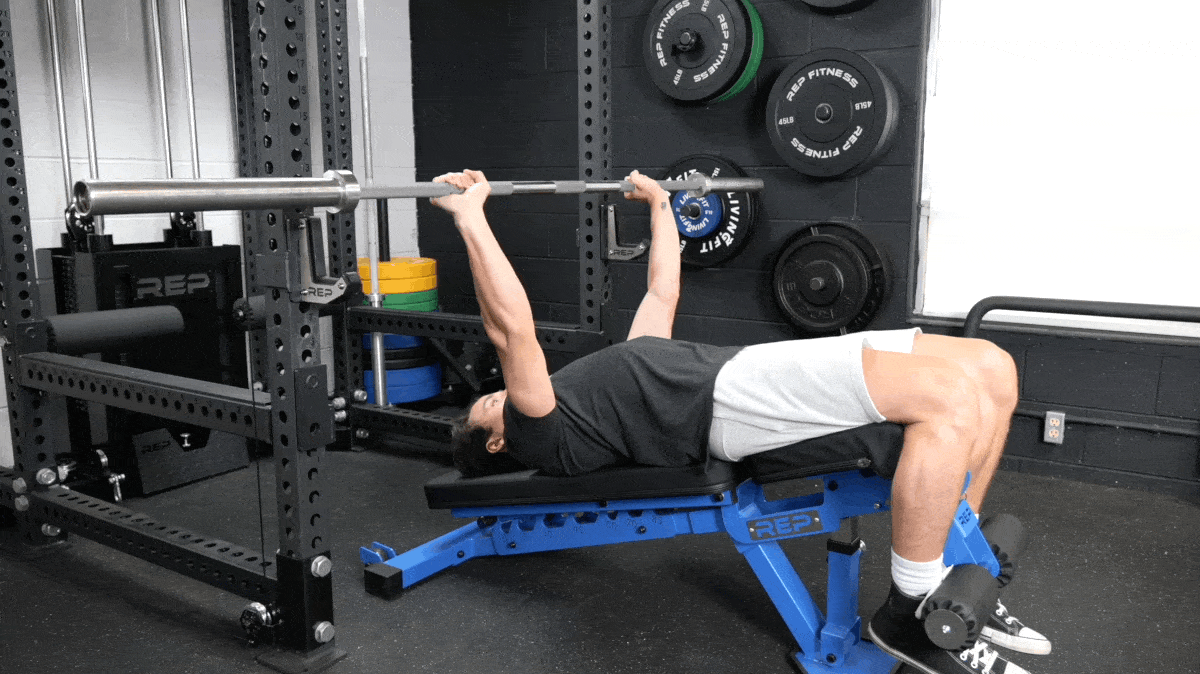
Plus, the elbows flaring out allows for a great and more intense stretch of the entire chest muscle. As a bonus, the decline bench is known to be a bit more shoulder-friendly compared to other pressing variations.
How to Do It
[*]Lie face up on a decline bench with the feet secured to avoid sliding off the bench.
[*]Get your eyes underneath the barbell, take a wider than shoulder-width grip, and set your shoulder blades together.
[*]Allow the shoulder and elbow joints to bend as you lower into the bottom of the press, with the elbows underneath the barbell.
[*]When in the bottom position, press the barbell back up to lockout position and repeat.
Coach’s Tip: The bar should make contact lower on the torso than in the flat or incline bench presses.
Sets and Reps: Go for 3 to 4 sets of 6 to 8 repetitions here.
2. Dip
Dips are often referred to as the squats of the upper body — they target all of the major muscles in your upper body and can be easily scaled to suit beginners and advanced lifters. The long range of motion of the dip puts a greater stretch on the lower chest and triceps for more strength and hypertrophy potential. Leaning forward here targets the lower chest, but this puts the anterior shoulder at risk, so be careful.
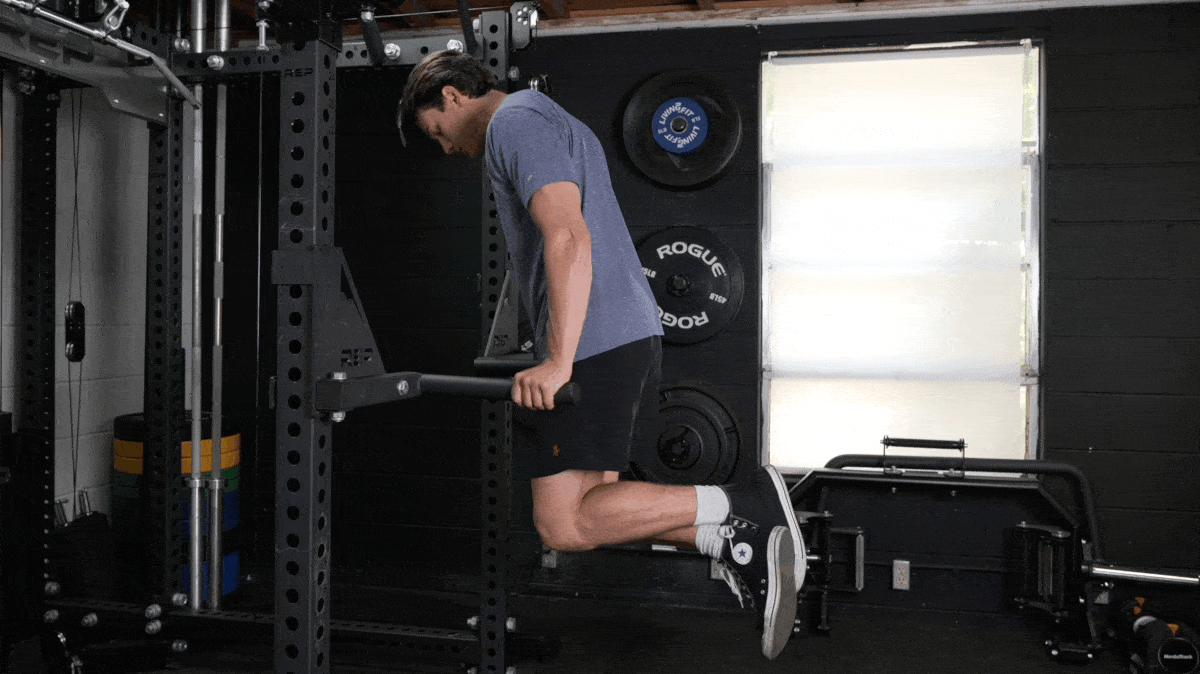
Beyond building your lower chest, dips offer improved lockout strength for exercises such as the bench press, overhead press, and Olympic lifts. They’re also customizable; you can adjust your posture to work more of your lower chest muscles by leaning forward.
How to Do It
[*]Stand between the dip bars and grip firmly, and engage the upper back by keeping your chest up and shoulders down.
[*]Squeeze the bar and press yourself upwards while maintaining a forward lean to target the lower chest.
[*]When approaching lockout, flex the back of your triceps, pause for a second, and slowly lower down and repeat.
Coach’s Tip: Keep your shoulders depressed and away from your ears as you lower yourself down.
Sets and Reps: Work up to 20 unbroken bodyweight only dips in a single set, then consider adding a small amount of weight.
3. Decline Dumbbell Fly
The decline dumbbell fly is a fly variation performed on a slight decline, which targets the lower chest muscles slightly more than the flat and incline variations. Like the decline bench press, this exercise decreases strain on the anterior shoulders compared to the incline version. Because the triceps and shoulders are less involved, this isolates the lower chest muscles even further.
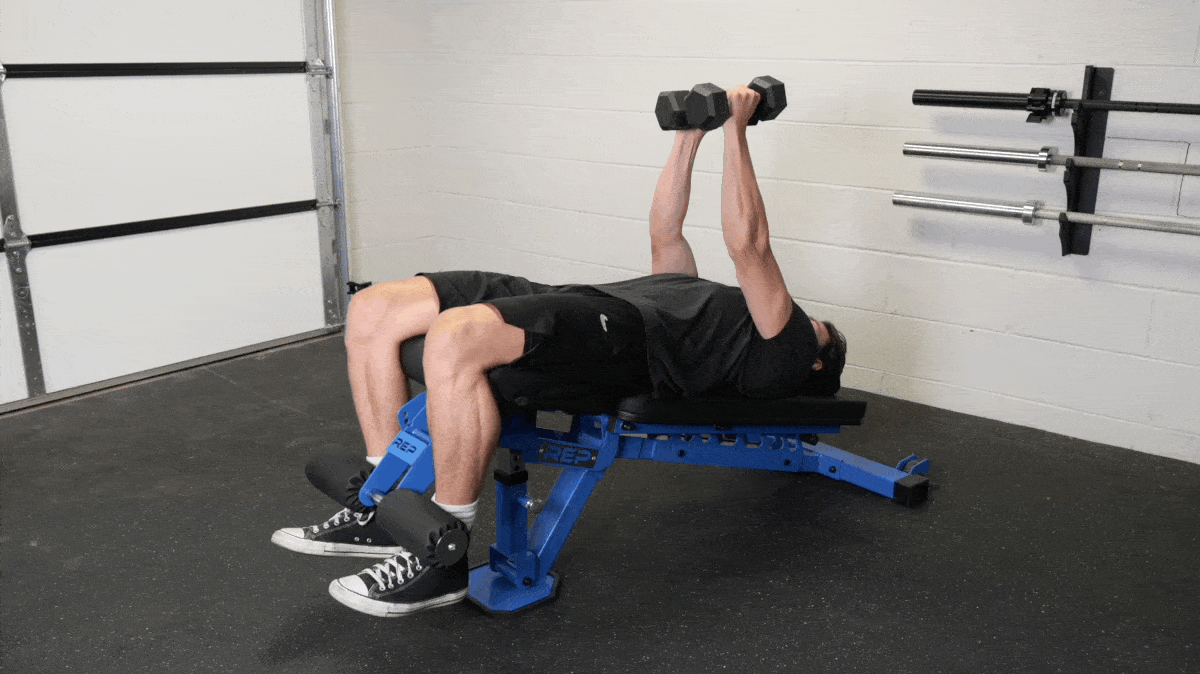
The decline dumbbell fly allows you to isolate your pecs without any involvement from your shoulders or triceps. Also, you may find that decline flys are easier on your shoulder capsule than the flat or incline versions.
How to Do It
[*]Lie supine on the decline bench with a pair of dumbbells held using a neutral grip near your chest and with your feet secured at the end on the bench.
[*]Then, press the weights to the lockout position.
[*]Lower the weights laterally, maintaining a slight bend at your elbows to avoid elbow strain.
[*]When the dumbbells are at chest level, squeeze your chest muscles, bring the weights back to the starting position, and repeat.
Coach’s Tip: Think about opening up your pecs, allowing the weights to pull your chest fibers apart.
Sets and Reps: Try 2 to 3 sets of up to 15 repetitions.
4. High Cable Fly
This exercise stretches the chest muscles from the start and takes you through a large range of motion for better muscle-building potential. Plus, due to the constant tension of the cable machine, your muscles are under tension longer for improved hypertrophy. Keeping a forward lean and a bend in the elbows will target the lower chest muscles further.
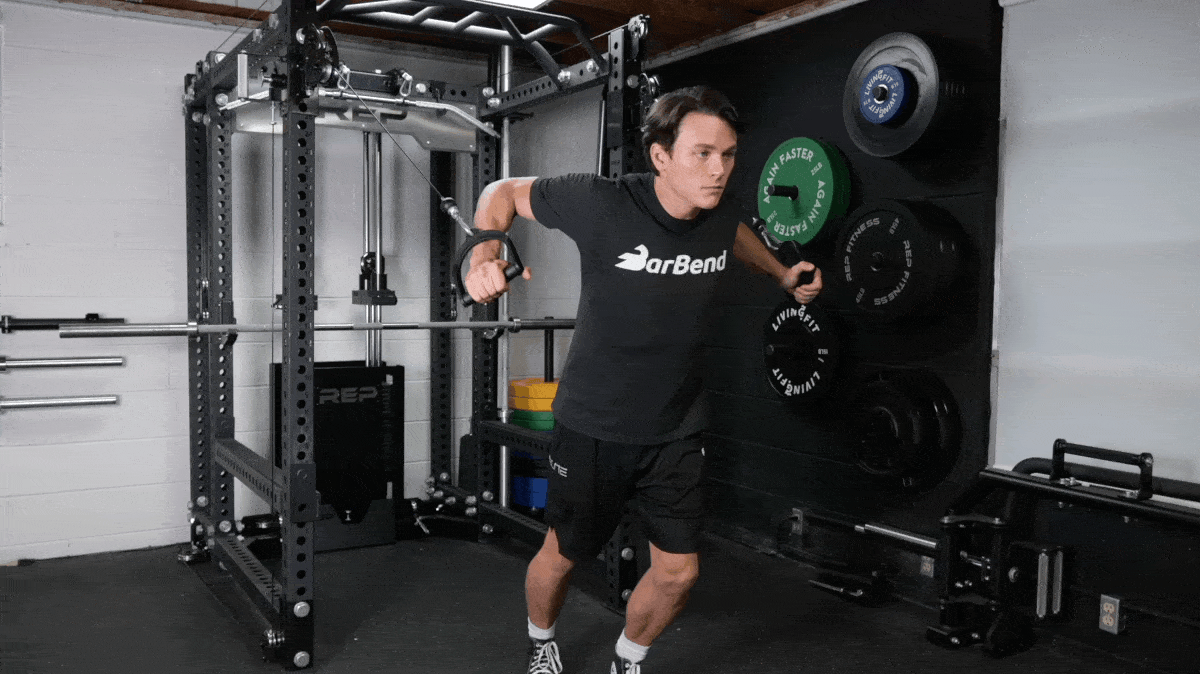
Working with cables provides more consistent mechanical tension than performing flys with dumbbells, which is great for hypertrophy. Cables are also adjustable, meaning you can tweak them until you feel your lower chest actively light up.
How to Do It
[*]Set the handles at both ends of the cable machine at the highest level. Stand in the center with a staggered stance and take hold of both handles.
[*]Lean your torso forward, keeping your spine in neutral, and bend your elbows slightly too.
[*]Keeping your core tight, pull both handles down and across your body and squeeze the chest muscles at the end of this movement.
[*]Slowly reverse to the start position, keeping the bend in your elbows, and repeat.
Coach’s Tip: Make sure the cables are set to above the height of your shoulders at minimum.
Sets and Reps: Bang out 3 to 4 sets of 12 to 15 repetitions on this one.
5. Jackhammer Pushdown
By slightly adjusting the triceps pushdown, you will target and build the lower chest. With the jackhammer pushdown, you’ll take your elbows out wide and lean the torso forward.
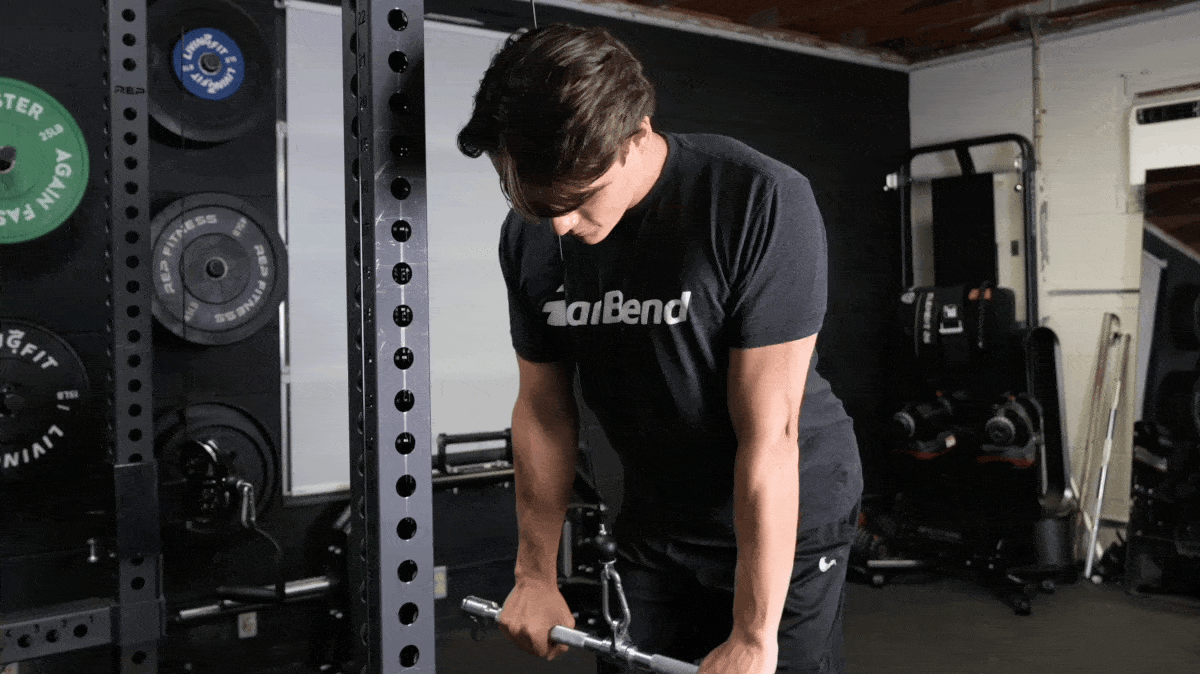
This angle isolates the lower chest muscles and reduces triceps involvement. Plus, the constant tension of the cable machine and the large ROM makes this an effective lower chest builder.
How to Do It
[*]Stand in front of the cable machine and use the same handle as you would for a triceps pushdown machine.
[*]Stand close to the machine with the cable over your shoulder, lean the torso forward and take a firm grip of the handle.
[*]Let your elbows flare out at the top of the movement and then push down to extend the elbows.
[*]Slowly come back to the starting position by opening the chest and bringing the elbows out and up.
Coach’s Tip: Think of this movement as similar to a close-grip bench press, but with deliberately flared arms.
Sets and Reps: Dial in your technique and then go for 2 to 3 sets of up to 12 repetitions.
6. Decline Push-Up
The classic push-up will never go out of style — and by adjusting the angle, you’ll get a decline push-up. When you put your feet on an incline, your chest will be in a declined position. This will challenge your lower chest more. You can put your feet on a weight bench to target your shoulders as well as your chest.
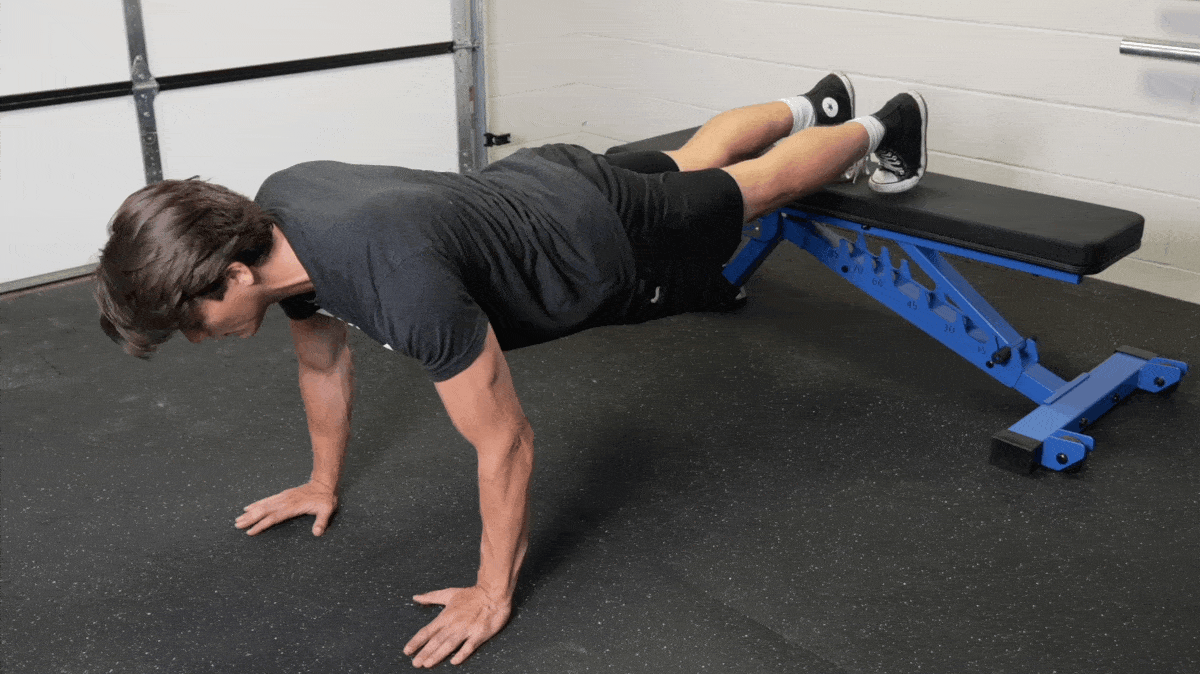
As with many push-up variations, you can potentially rep out for added volume. The higher the volume, the better your lower chest muscle-building potential. Because it’s a bodyweight exercise, you’ll be able to add more volume for more muscle-building tension over time.
How to Do It
[*]Kneel with a bench, box, or step behind you. Place your toes on the bench.
[*]Walk out into the push-up position. Place your hands underneath your shoulders, squeeze your glutes, and screw your hands into the ground.
[*]Slowly lower down until your chest is about an inch from the floor. Drive your hands through the floor and lock out your elbows.
Coach’s Tip: The decline push-up is notably more difficult than a standard flat push-up. Begin with those before progressing here.
Sets and Reps: Work up to 3 to 4 sets of 15 to 20 repetitions.
7. Dumbbell Hip Extension Floor Press
If you don’t have a decline bench, the dumbbell hip extension floor press is also a great option. You simulate a decline angle for your chest by performing a standard glute bridge. Here, you’ll train the lower chest muscle fibers while improving hip mobility and glute strength. Both of these have great carryover to create lower body drive with the regular bench press.
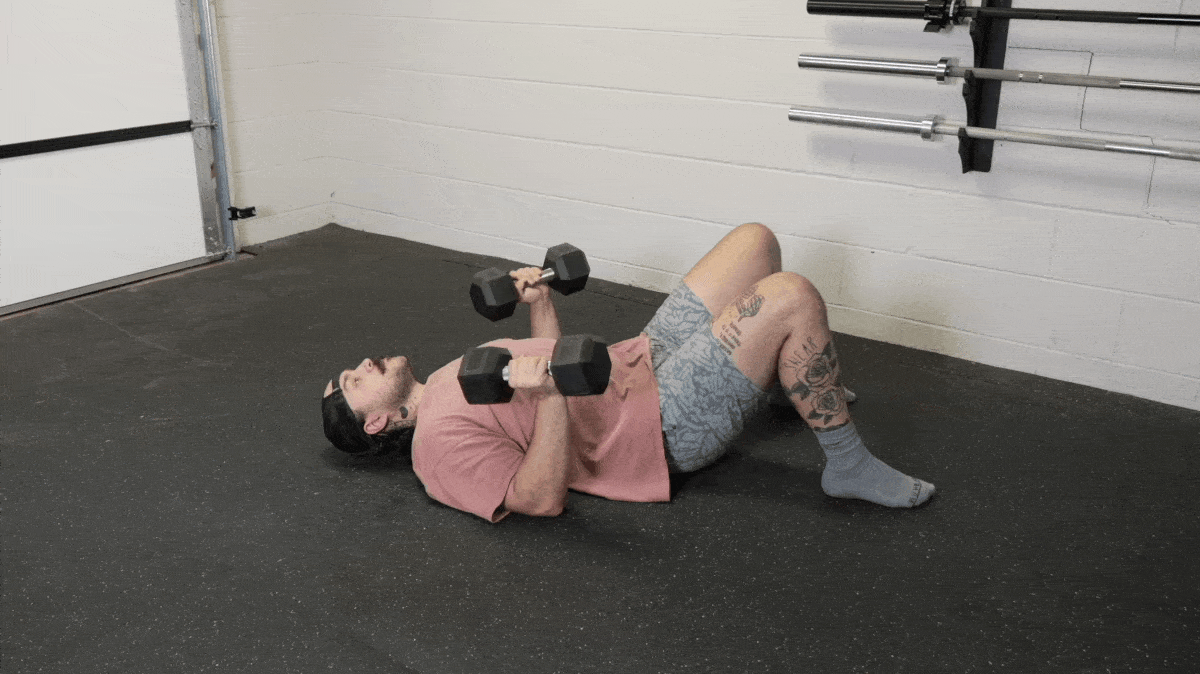
Plus, because you’re pressing with dumbbells, you’ll help strengthen imbalances between sides for better muscle development. This is a relatively safe and easy variation to perform — and you don’t need a decline bench to do it.
How to Do It
[*]Lie on the floor holding a dumbbell in each hand with a neutral grip.
[*]Plant with your feet flat on the floor. Place your elbows away from your torso.
[*]Press your feet through the floor and raise your hips into extension.
[*]Press the dumbbells up until your elbows are locked out. Slowly return until your upper arms touch the floor.
Coach’s Tip: Actively squeeze your glutes during the eccentric portion of the press to maintain a proper bridge.
Sets and Reps: Work up to 2 to 3 sets of 15 repetitions.
Lower Chest Warm-Up
Performing some light sets or ramp-up sets with exercise you’re about to do is one way to warm up. Not only will ramping up sets grease the groove and help you decide your working weight for the day, but the extra volume is helpful for fat loss and hypertrophy goals. Here’s an example of ramp-up sets for the decline bench press:
How to Train Your Lower Chest
Bear in mind that your lower chest isn’t a separate muscle altogether; it is a region of your pecs that you’re looking to give a bit of extra love to. As such, you probably don’t want to dedicate an entire day in your weekly workout split to your lower pecs. Follow standard progression rules, make some specific exercise swaps, and you’ll be well on your way.
Lower Chest Exercise Selection
Luckily, morphing your standard chest or upper-body push workout into something that emphasizes the lower pecs is quite easy. All you need to do is replace your existing pressing exercises with lower-chest-friendly variations. For example, if you usually begin your workout with a flat dumbbell bench press, head to the decline bench station instead.
The same idea applies to machine work and calisthenics. Finish off your workouts with a cluster set of high-to-low cable flyes rather than flat push-ups and you’ll all but guarantee you leave the gym with your lower pecs burnt to a crisp.
Lower Chest Sets and Reps
When it comes to programming specific exercises, the rules of the game don’t change just because you want to bring up a lagging body part. For lower chest exercises, treat them as any other body part. Use moderate reps and heavy weights during compound movements, and save the high-repetition work for the end.
Your lower chest can be quite tricky to target, but the best way to avoid frustration (or stagnation) is to approach your workouts smartly. Here are a few lower-chest specific tips you can apply to get the most value out of your workouts:
Find the Right Angle
Your muscles are a series of levers and pulleys, and they all obey the laws of physics. As such, certain areas of your chest are liable to perform more work depending on the angle of the surrounding joints. In short, this means that your lower chest will get off the bench and into the game if you take time to find a pressing angle that consciously stimulates those fibers.
Use Pre-Exhaustion
When it comes to any exercise that involves more than one muscle group, you’re only as strong as your weakest link. On the bench press, for instance, your triceps or shoulders may the rate limiters — they fail first, preventing you from stimulating all the fibers in your pecs during your set.
You can get around this by performing some pre-exhaustion exercises instead. This method involves doing movements that directly target your “supplemental” muscles first. On chest day, this can look like beginning with triceps pressdowns or front raises before hitting up the bench press.
Benefits of Training Your Lower Chest
Besides building a bigger and fuller chest, there are many important benefits from focusing on your lower chest 9and your chest in general).
Improved Posture
As it’s one of the largest muscles in the upper body, the chest plays a major role in assisting good posture as its length and strength dictate your shoulder position. The pecs, along with the upper back and shoulder, help to stabilize the entire shoulder joint.
Better Breathing
Strengthening and lengthening the chest muscles support deeper breathing through expansion and contraction of the ribcage. Your pecs are attached to your ribcage, which expands with every breath, and if they are tight or short, this will affect your ability to breathe deeply.
Improved Athletic Performance
As the pecs are your hugging muscle, their size and strength help tackle and fend off opponents of the football field. And they assist in hitting a tennis ball, throwing a football and baseball faster and harder.
What Muscles Make Up the Lower Chest
Your chest is a large superficial muscle running at different angles with multiple attachment points. Understanding what they are and how they work is important in obtaining a stronger chest. The chest is made up of two muscles, the pectoralis major and the pectoralis minor muscle.
Now that you have a handle on the lower chest exercises to strengthen and develop your chest, you can also check out these other helpful chest training articles for strength, power, and fitness athletes.
Click here to view the article.
The post The 7 Best Lower Chest Exercises for Building Strong and Full Pecs appeared first on BarBend.
The best way to add size and strength to your chest is to press, press, do a fly, and press some more. But to build a well-defined chest that stands out, you need to target the lower chest — the area of the muscle that sweeps from under the armpit (near the serratus muscle) to underneath the nipple.
Neglect the lower chest (and the upper chest, for that matter), and you won’t have that large and full look that bodybuilders like Arnold Schwarzenegger and Franco Columbu made famous. Also, a larger chest is often a stronger chest. The pecs are large fan-like muscles with two heads — the clavicle and the sternal head. To isolate the lower chest (sternal) requires you to change the angle of your press to emphasize this neglected part of the chest.
Credit: YAKOBCHUK VIACHESLAV / Shutterstock
You do this by either performing exercises on a decline bench or leaning forward with traditional exercises like dips and pushdowns. Here are seven of the best lower chest exercises that do just that.
7 Best Lower Chest Exercises
[*]Decline Bench Press
[*]Dip
[*]Decline Dumbbell Fly
[*]High Cable Fly
[*]Jackhammer Pushdown
[*]Decline Push-Up
[*]Dumbbell Hip Extension Floor Press
1. Decline Bench Press
The decline bench press is often overlooked in favor of the flat or incline version. And that’s a shame because you’re leaving gains on the table. Although the flat version works the lower chest, the decline variation really focuses on the lower chest because the angle changes the pressing path.

Plus, the elbows flaring out allows for a great and more intense stretch of the entire chest muscle. As a bonus, the decline bench is known to be a bit more shoulder-friendly compared to other pressing variations.
How to Do It
[*]Lie face up on a decline bench with the feet secured to avoid sliding off the bench.
[*]Get your eyes underneath the barbell, take a wider than shoulder-width grip, and set your shoulder blades together.
[*]Allow the shoulder and elbow joints to bend as you lower into the bottom of the press, with the elbows underneath the barbell.
[*]When in the bottom position, press the barbell back up to lockout position and repeat.
Coach’s Tip: The bar should make contact lower on the torso than in the flat or incline bench presses.
Sets and Reps: Go for 3 to 4 sets of 6 to 8 repetitions here.
2. Dip
Dips are often referred to as the squats of the upper body — they target all of the major muscles in your upper body and can be easily scaled to suit beginners and advanced lifters. The long range of motion of the dip puts a greater stretch on the lower chest and triceps for more strength and hypertrophy potential. Leaning forward here targets the lower chest, but this puts the anterior shoulder at risk, so be careful.

Beyond building your lower chest, dips offer improved lockout strength for exercises such as the bench press, overhead press, and Olympic lifts. They’re also customizable; you can adjust your posture to work more of your lower chest muscles by leaning forward.
How to Do It
[*]Stand between the dip bars and grip firmly, and engage the upper back by keeping your chest up and shoulders down.
[*]Squeeze the bar and press yourself upwards while maintaining a forward lean to target the lower chest.
[*]When approaching lockout, flex the back of your triceps, pause for a second, and slowly lower down and repeat.
Coach’s Tip: Keep your shoulders depressed and away from your ears as you lower yourself down.
Sets and Reps: Work up to 20 unbroken bodyweight only dips in a single set, then consider adding a small amount of weight.
3. Decline Dumbbell Fly
The decline dumbbell fly is a fly variation performed on a slight decline, which targets the lower chest muscles slightly more than the flat and incline variations. Like the decline bench press, this exercise decreases strain on the anterior shoulders compared to the incline version. Because the triceps and shoulders are less involved, this isolates the lower chest muscles even further.

The decline dumbbell fly allows you to isolate your pecs without any involvement from your shoulders or triceps. Also, you may find that decline flys are easier on your shoulder capsule than the flat or incline versions.
How to Do It
[*]Lie supine on the decline bench with a pair of dumbbells held using a neutral grip near your chest and with your feet secured at the end on the bench.
[*]Then, press the weights to the lockout position.
[*]Lower the weights laterally, maintaining a slight bend at your elbows to avoid elbow strain.
[*]When the dumbbells are at chest level, squeeze your chest muscles, bring the weights back to the starting position, and repeat.
Coach’s Tip: Think about opening up your pecs, allowing the weights to pull your chest fibers apart.
Sets and Reps: Try 2 to 3 sets of up to 15 repetitions.
4. High Cable Fly
This exercise stretches the chest muscles from the start and takes you through a large range of motion for better muscle-building potential. Plus, due to the constant tension of the cable machine, your muscles are under tension longer for improved hypertrophy. Keeping a forward lean and a bend in the elbows will target the lower chest muscles further.

Working with cables provides more consistent mechanical tension than performing flys with dumbbells, which is great for hypertrophy. Cables are also adjustable, meaning you can tweak them until you feel your lower chest actively light up.
How to Do It
[*]Set the handles at both ends of the cable machine at the highest level. Stand in the center with a staggered stance and take hold of both handles.
[*]Lean your torso forward, keeping your spine in neutral, and bend your elbows slightly too.
[*]Keeping your core tight, pull both handles down and across your body and squeeze the chest muscles at the end of this movement.
[*]Slowly reverse to the start position, keeping the bend in your elbows, and repeat.
Coach’s Tip: Make sure the cables are set to above the height of your shoulders at minimum.
Sets and Reps: Bang out 3 to 4 sets of 12 to 15 repetitions on this one.
5. Jackhammer Pushdown
By slightly adjusting the triceps pushdown, you will target and build the lower chest. With the jackhammer pushdown, you’ll take your elbows out wide and lean the torso forward.

This angle isolates the lower chest muscles and reduces triceps involvement. Plus, the constant tension of the cable machine and the large ROM makes this an effective lower chest builder.
How to Do It
[*]Stand in front of the cable machine and use the same handle as you would for a triceps pushdown machine.
[*]Stand close to the machine with the cable over your shoulder, lean the torso forward and take a firm grip of the handle.
[*]Let your elbows flare out at the top of the movement and then push down to extend the elbows.
[*]Slowly come back to the starting position by opening the chest and bringing the elbows out and up.
Coach’s Tip: Think of this movement as similar to a close-grip bench press, but with deliberately flared arms.
Sets and Reps: Dial in your technique and then go for 2 to 3 sets of up to 12 repetitions.
6. Decline Push-Up
The classic push-up will never go out of style — and by adjusting the angle, you’ll get a decline push-up. When you put your feet on an incline, your chest will be in a declined position. This will challenge your lower chest more. You can put your feet on a weight bench to target your shoulders as well as your chest.

As with many push-up variations, you can potentially rep out for added volume. The higher the volume, the better your lower chest muscle-building potential. Because it’s a bodyweight exercise, you’ll be able to add more volume for more muscle-building tension over time.
How to Do It
[*]Kneel with a bench, box, or step behind you. Place your toes on the bench.
[*]Walk out into the push-up position. Place your hands underneath your shoulders, squeeze your glutes, and screw your hands into the ground.
[*]Slowly lower down until your chest is about an inch from the floor. Drive your hands through the floor and lock out your elbows.
Coach’s Tip: The decline push-up is notably more difficult than a standard flat push-up. Begin with those before progressing here.
Sets and Reps: Work up to 3 to 4 sets of 15 to 20 repetitions.
7. Dumbbell Hip Extension Floor Press
If you don’t have a decline bench, the dumbbell hip extension floor press is also a great option. You simulate a decline angle for your chest by performing a standard glute bridge. Here, you’ll train the lower chest muscle fibers while improving hip mobility and glute strength. Both of these have great carryover to create lower body drive with the regular bench press.

Plus, because you’re pressing with dumbbells, you’ll help strengthen imbalances between sides for better muscle development. This is a relatively safe and easy variation to perform — and you don’t need a decline bench to do it.
How to Do It
[*]Lie on the floor holding a dumbbell in each hand with a neutral grip.
[*]Plant with your feet flat on the floor. Place your elbows away from your torso.
[*]Press your feet through the floor and raise your hips into extension.
[*]Press the dumbbells up until your elbows are locked out. Slowly return until your upper arms touch the floor.
Coach’s Tip: Actively squeeze your glutes during the eccentric portion of the press to maintain a proper bridge.
Sets and Reps: Work up to 2 to 3 sets of 15 repetitions.
Lower Chest Warm-Up
Performing some light sets or ramp-up sets with exercise you’re about to do is one way to warm up. Not only will ramping up sets grease the groove and help you decide your working weight for the day, but the extra volume is helpful for fat loss and hypertrophy goals. Here’s an example of ramp-up sets for the decline bench press:
- 10 reps with an empty barbell
- Eight reps with 135 pounds
- Six reps with 155 pounds
- Five reps with 165 pounds
- Four reps with 175 pounds
How to Train Your Lower Chest
Bear in mind that your lower chest isn’t a separate muscle altogether; it is a region of your pecs that you’re looking to give a bit of extra love to. As such, you probably don’t want to dedicate an entire day in your weekly workout split to your lower pecs. Follow standard progression rules, make some specific exercise swaps, and you’ll be well on your way.
Lower Chest Exercise Selection
Luckily, morphing your standard chest or upper-body push workout into something that emphasizes the lower pecs is quite easy. All you need to do is replace your existing pressing exercises with lower-chest-friendly variations. For example, if you usually begin your workout with a flat dumbbell bench press, head to the decline bench station instead.
The same idea applies to machine work and calisthenics. Finish off your workouts with a cluster set of high-to-low cable flyes rather than flat push-ups and you’ll all but guarantee you leave the gym with your lower pecs burnt to a crisp.
Lower Chest Sets and Reps
When it comes to programming specific exercises, the rules of the game don’t change just because you want to bring up a lagging body part. For lower chest exercises, treat them as any other body part. Use moderate reps and heavy weights during compound movements, and save the high-repetition work for the end.
- For Free Weight or Compound Exercises: Go for 1 to 3 exercises consisting of 2 to 4 sets each with anywhere from 5 to 10 repetitions.
- For Isolation Exercises: For movements like the decline push-up or cable fly, keep the repetitions higher, between 12 and as high as 20.
Your lower chest can be quite tricky to target, but the best way to avoid frustration (or stagnation) is to approach your workouts smartly. Here are a few lower-chest specific tips you can apply to get the most value out of your workouts:
Find the Right Angle
Your muscles are a series of levers and pulleys, and they all obey the laws of physics. As such, certain areas of your chest are liable to perform more work depending on the angle of the surrounding joints. In short, this means that your lower chest will get off the bench and into the game if you take time to find a pressing angle that consciously stimulates those fibers.
Use Pre-Exhaustion
When it comes to any exercise that involves more than one muscle group, you’re only as strong as your weakest link. On the bench press, for instance, your triceps or shoulders may the rate limiters — they fail first, preventing you from stimulating all the fibers in your pecs during your set.
You can get around this by performing some pre-exhaustion exercises instead. This method involves doing movements that directly target your “supplemental” muscles first. On chest day, this can look like beginning with triceps pressdowns or front raises before hitting up the bench press.
Benefits of Training Your Lower Chest
Besides building a bigger and fuller chest, there are many important benefits from focusing on your lower chest 9and your chest in general).
Improved Posture
As it’s one of the largest muscles in the upper body, the chest plays a major role in assisting good posture as its length and strength dictate your shoulder position. The pecs, along with the upper back and shoulder, help to stabilize the entire shoulder joint.
Better Breathing
Strengthening and lengthening the chest muscles support deeper breathing through expansion and contraction of the ribcage. Your pecs are attached to your ribcage, which expands with every breath, and if they are tight or short, this will affect your ability to breathe deeply.
Improved Athletic Performance
As the pecs are your hugging muscle, their size and strength help tackle and fend off opponents of the football field. And they assist in hitting a tennis ball, throwing a football and baseball faster and harder.
What Muscles Make Up the Lower Chest
Your chest is a large superficial muscle running at different angles with multiple attachment points. Understanding what they are and how they work is important in obtaining a stronger chest. The chest is made up of two muscles, the pectoralis major and the pectoralis minor muscle.
- Pectoralis Major: A large superficial muscle located on the anterior surface of the thoracic rib cage. Has two major heads, the clavicular head, which is in the upper region of the chest, and the sternal head is in the middle to lower chest region.
- Pectoralis Minor: A superficial muscle on the anterior aspect of the chest, located deep to the pectoralis major muscle.
Now that you have a handle on the lower chest exercises to strengthen and develop your chest, you can also check out these other helpful chest training articles for strength, power, and fitness athletes.
- How to Do the Bench Press for a Bigger and Stronger Chest
- 6 Chest Exercises Without Weights That Build Size and Strength
- Want a Big and Strong Chest? Start Using the Svend Press in Your Training
Click here to view the article.

